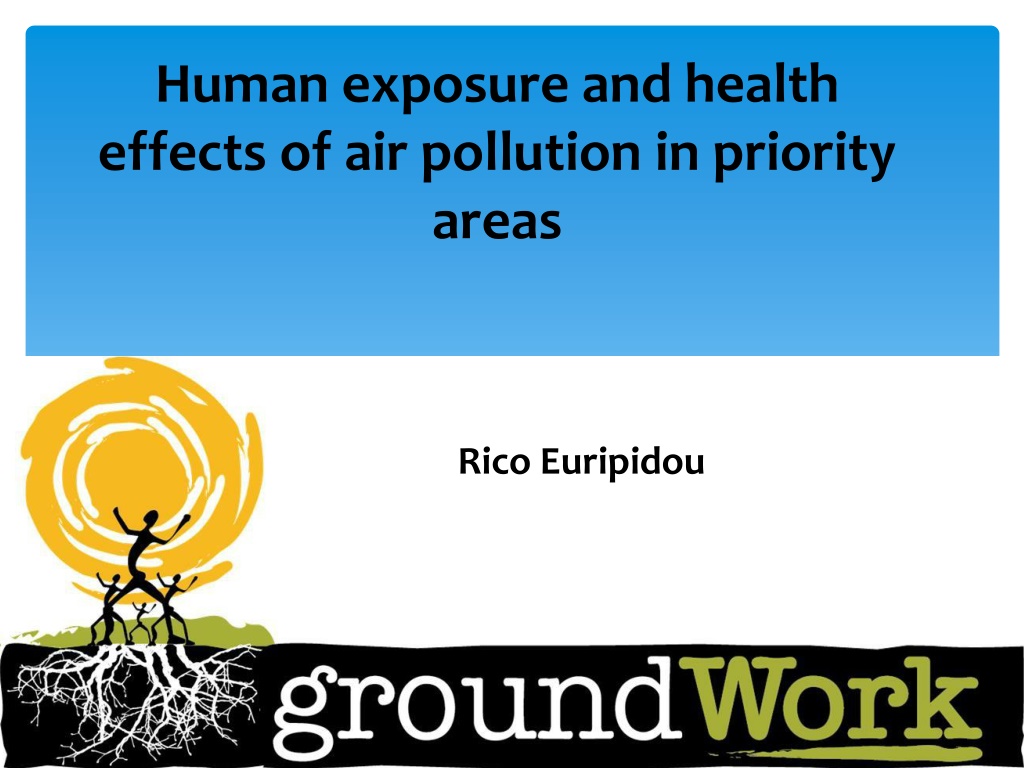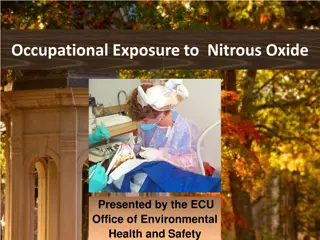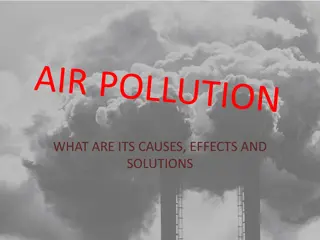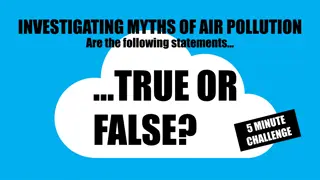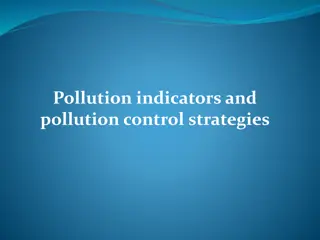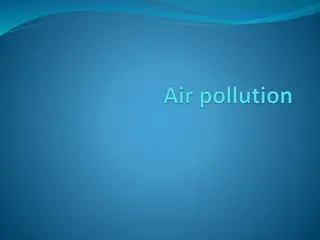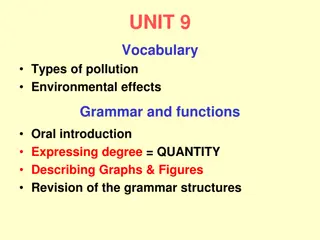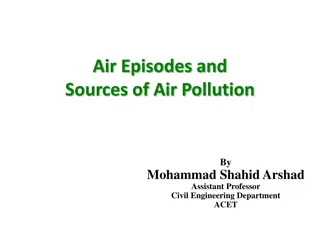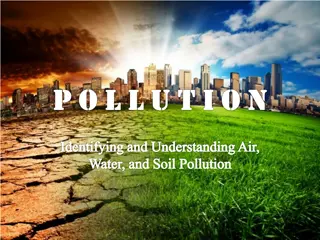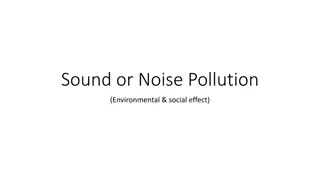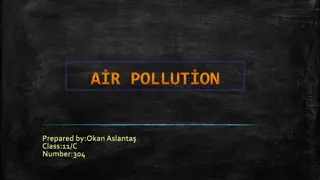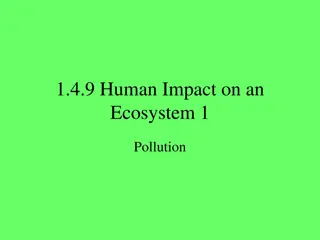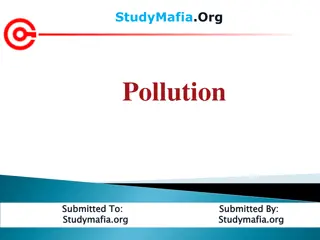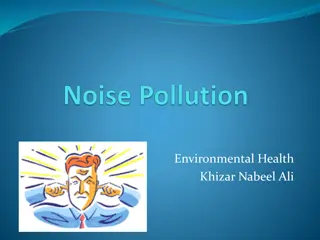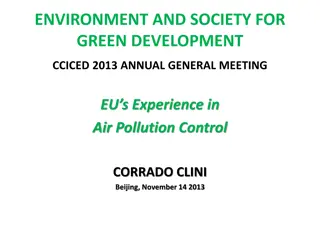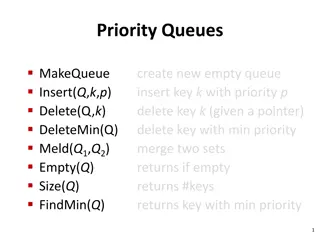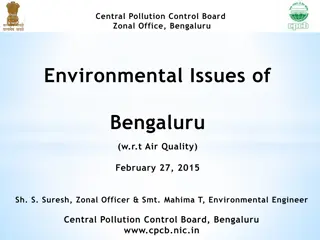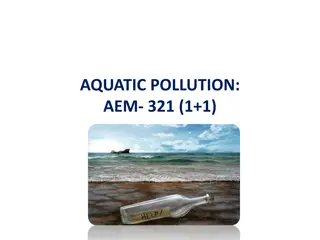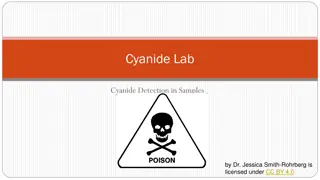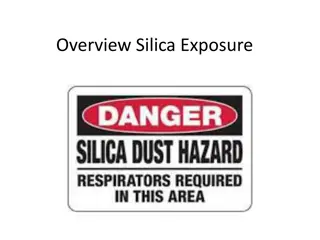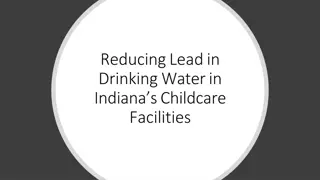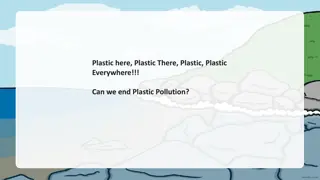Human Exposure and Health Effects of Air Pollution in Priority Areas
Assessing the impact of air pollution on human health in priority areas, focusing on initiatives aimed at improving environmental governance, monitoring air quality, and addressing extreme climate events. The discussion includes the health care costs associated with air pollution and the significant number of deaths linked to outdoor air pollution's various causes.
Download Presentation

Please find below an Image/Link to download the presentation.
The content on the website is provided AS IS for your information and personal use only. It may not be sold, licensed, or shared on other websites without obtaining consent from the author. Download presentation by click this link. If you encounter any issues during the download, it is possible that the publisher has removed the file from their server.
E N D
Presentation Transcript
Human exposure and health effects of air pollution in priority areas Rico Euripidou Rico Euripidou
Who are we? groundWork is a non-profit environmental justice service and developmental organisation aimed at improving the quality of life of vulnerable people in South Africa, through assisting civil society to have a greater impact on environmental governance. One of groundWork s campaigns relates to air quality and it works with community people to monitor the implementation of the National Environmental Management: Air Quality Act, 2005 (AQA) in the priority areas over the past 20 years.
Some extreme climate events in 2015-17 Drought W.&E.Cape; Wildfires Knysna Drought California, Sao Paulo, Drought KZN + FS + Mp + Southern Africa Flooding Southern Africa in Feb 2015 and flash floods 2017. Caribbean hurricane season 2017 Philippines Typhoons Arctic heatwave making Europe freeze 2018
Mining Transpor t Coal Toxic Slurry Burning Combustion Waste
Health Care Costs of Air Pollution WHOestimates 7 Million Deaths Linked to Air Pollution in 2012 Excessive air pollution is often a by-product of unsustainable policies in sectors such as transport, energy, waste management and industry. In most cases, healthier strategies will also be more economical in the long term due to health-care cost savings as well as climate gains Outdoor Air Pollution Causes of Death ischaemic heart disease stroke chronic obstructive pulmonary disease (COPD) lung cancer acute lower respiratory infections in children Dr Carlos Dora Source: World Health Organization (WHO) URL: http://www.who.int/mediacentre/news/releases/2014/air- pollution/en/ WHO Coordinator for Public Health, Environmental and Social Determinants of Health
WHO Annual Global Deaths in 2012 (millions) Source: World Health Organization
Cumulative impacts of coal and community health Particle pollution (PM10, PM2.5, PM1) is one of the most dangerous pollutants for human health. It causes cardiovascular and respiratory disease, asthma, hospital admissions and premature death. PM10 & PM2.5 levels in the Vaal and the Highveld exceeded the national annual standard permanently over the last 5 years
Air quality limits and public protection Neither the concentration limits set by governments nor the World Health Organization s air quality guidelines are fully protective of health 14
Annual Emissions by Eskom CFPS 2008-17
Annual Emissions per unit of coal- generated electricity
Eskom self reported PM10 WHO WHO (2005) : recommended annual ambient standard 20ug/m3
WHO WHO (2005) : recommended annual ambient standard 20ug/m3
Annual average PM10 concentrations in the Waterberg Priority Area 2013-2016 WHO WHO (2005): recommended annual ambient standard 20ug/m3
Annual average PM2.5 concentrations in the Waterberg Priority Area 2013-2016 WHO WHO: (2005) recommended annual ambient standard: 10ug/m3
Annual average PM2.5 concentrations in the Highveld Priority Area 2012-2015 Tshwane & Jhb 39ug/m3!! Ekurhuleni 50ug/m3!! SA NAAQS WHO Cairncross, E. (2016). The State of South Africa s Air Quality Monitoring Network and Its Air Quality. Paper presented at the National Association for Clean Air.
DEA MSRG presentation of the State of the Air report 2017
SAs MES are extremely lax compared with international practice! Existing Plant ratios: SA/ country SO2 PM SA/ China SA/ Germany SA/ India SA/ Indonesia SA/ Thailand SA/ EU IED 17.5 17.5 5.8 4.7 1.7 17.5 3.3 5.0 1.0 0.7 0.6 5.0 New Plant ratios: SA/ country SO2 PM SA/ China SA/ Germany SA/ India SA/ Indonesia SA/ Thailand SA/ EU IED 14.3 3.3 5.0 0.7 1.0 3.3 5.0 5.0 1.7 0.5 0.6 5.0 Ref.: http://www.iea-coal.org.uk/documents/83882/9684/Emission- standards-and-control-of-PM2.5-from-coal-fired-power-plant,- CCC/267
Health impacts of delays in meeting emission limit values by coal fired power plants in South Africa Dr Mike Holland (EMRC) mike.holland@emrc.co.uk 26/3/2017 Worked for European Commission, various governments (UK, France, Sweden, China), the European Commission, OECD, World Bank. Report provides estimates of the health impacts and associated economic costs of current emissions of air pollutants from coal fired power stations in South Africa. Results are provided both in aggregate, and disaggregated to individual Eskom power stations.
Impact pathway approach EMISSIONS Tracks emissions through to impacts using best available science e.g. tonnes of SO2 DISPERSION Increase in ambient concentrations e.g. local and regional ppb SO2 IMPACT IMPACT Using exposure-response curves, e.g. change in crop yield per ppb together with geographical databases of receptors (e.g. people, crops, buildings) CONCENTRATION COST Damage costs (e.g. market price) Willingness to Pay 26
Starting point: emissions from the power stations 27
Forecast annual average PM2.5 contribution from plant covered by Eskom s application for emission limit derogation, ug.m-3 28
Annual impacts of coal fired generation in South Africa 30
Health impacts of coal fired power plants in South Africa, 2017 https://cer.org.za/news/air-pollution-from-coal-power-stations-causes-disease-and-kills- thousands-of-south-africans-every-year-says-uk-expert
Health impacts and associated costs ($int, millions) allocated to individual power stations.
http://www.theigc.org/blog/the-cost-of-air-pollution-in-south-africa/http://www.theigc.org/blog/the-cost-of-air-pollution-in-south-africa/
Benefits & costs of the Clean Air Act, a law which regulates emissions of sulfur dioxide, oxides of nitrogen, carbon monoxide, and particulate matter in USA were calculated. The ratio of health care cost savings to compliance costs was 25:1 in 2010. For every dollar spent complying with the Clean Air Act, twenty-five dollars were saved in health care costs due to lower disease burden, including a reduction in premature deaths, and cases of bronchitis, asthma, and myocardial infarction. US Environmental Protection Agency Office, 2010 34
Key issues There is a delink between AQ planning between DEA and DoH! We need to track pollution & health effects/costs in real time to make informed decisions! MES postponements are responsible for bulk of emissions! MES stds. are not a measure of BAT/BEP! MSRG meetings inefficient to resolve ambient AQ exceedances! All energy planning should be in line with a just transition by ESKOM to a renewable energy future!
Thank you! All resources available at: www.healthyenergyinitiative.org Briefing Papers Fact Sheets Infographics Stay in touch: rico@groundwork.org.za
